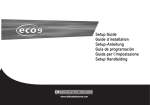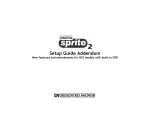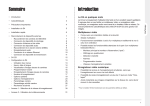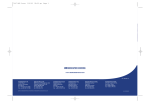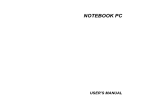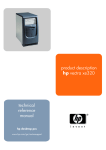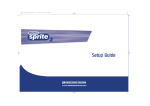Download Yamaha CRW2200SX Setup guide
Transcript
Setup Guide www.dedicatedmicros.com Warning: Do not move the unit whilst the power is connected. Introduction Contents • Introduction 1 What is Eco4? • Features 2 Eco4 is a cost effective and easy to use video multiplexer, digital video recorder, • Important Safeguards 3 and network video transmitter in a one box solution. • Installing Eco4 4 A video multiplexer? • Quick Install 5 • Connecting External Devices 6 • Easy to use. • Designed with security in mind. - Connecting Storage Devices 6 • Operates like a traditional multiplexer, not a PC - Connecting to Alarms & Relays 6 • All the feature you would expect from a Dedicated Micros multiplexer: - Connecting to an Ethernet network 7 - Connecting Dial-up Devices 8 • Configuring Eco4 - Main and Spot monitor. - Quad displays. 8 - Activity detection. - Using the Menu 8 - Alarms. - Time, Date & Language 10 - Scheduling. - Camera Viewing 11 - Schedule 11 - Variable record rates. - Record Schedule 12 - System Options 14 - Record Options 16 - Camera Setup 17 • 31 days or more of time-lapse recordings in one box*. - Activity Camera Setup 18 • Instant access to images recorded on the hard disk with no tapes 18 Network transmission? • Using Eco4 A digital video recorder? • Playback and record simultaneously, without affecting recording • View live and playback images across the network. • No extra software to buy, Network Viewing software for Windows™ provided. • Copy images across the network *Refers to the 160 GB model at default settings. 1 Features: Installation Auto detect cameras on power up Auto detect external storage on power up Default recording Loop-through connections Network Viewing 4 4 4 4 Live viewing Playback viewing Up to 5 network users at once Copy images across networks E-mail on event activation 4 4 4 4 External storage devices Operation Play, record, copy and transmit simultaneously Real-time quad updates Hidden camera option Scheduling Yamaha/Plextor CDR (check for compatible models) Playback VCR style playback Full, Quad, and PIP playback 4 4 The manual has three parts: Events Activity detection Alarms Event log with preview window 4 4 4 1. Installing Eco4 2. Configuring Eco4 3. Using Eco4 2 4 4 4 4 4 4 Important Safeguards Read Instructions REGULATORY NOTES FCC AND DOC INFORMATION All the safety and operating instructions should be read before the unit is operated. (USA and Canadian Models Only) Power Sources WARNING: This equipment has been tested and found to comply with the limits for a Class A digital device, pursuant to part 15 of the FCC rules. These limits are designed to provide reasonable protection against harmful interference when the equipment is operated in a commercial environment. This equipment generates, uses, and can radiate radio frequency energy and, if not installed and used in accordance with the instruction manual, may cause harmful interference to radio communications. Operation of this equipment in a residential area is likely to cause harmful interference in which case the user will be required to correct the interference at their own expense. This unit should be operated only from the type of power source indicated on the manufacturer’s label. Servicing Do not attempt to service this unit yourself as opening or removing covers may expose you to dangerous voltage or other hazards. Refer all servicing to qualified service personnel. Ventilation Ensure unit is properly ventilated to protect from overheating. WARNING To prevent fire or shock hazard, do not expose this equipment to rain or moisture. The lightning flash with arrowhead symbol within an equilateral triangle is intended to alert the user of this equipment that there are dangerous voltages within the enclosure which may be of sufficient magnitude to constitute a risk of electric shock. WARNING This is a class A product. In a domestic environment this product may cause radio interference in which case the user may be required to take adequate measures. If necessary, the user should consult the dealer or an experienced radio/television technician for corrective action. The user may find the following booklet prepared by the Federal Communications Commission helpful: “How to Identify and Resolve Radio-TV Interference Problems”. This booklet is available from the US Government Printing Office, Washington, DC20402, Stock No. 004-000-00345-4. This reminder is provided to call the CATV system installer’s attention to Art. 820-40 of the NEC that provides guidelines for proper grounding and, in particular, specifies that the cable ground shall be connected to the grounding system of the building, as close to the point of cable entry as practical. CE Mark This product is marked with the CE symbol and indicates compliance with all applicable directives. Directive 89/336/EEC. A “Declaration of Conformity” is held at Dedicated Micros Ltd., 11 Oak Street, Swinton, Manchester M27 4FL. 3 Installing BEFORE YOU START: A quick overview of digital recording Check the contents of the box Digital multiplex recorders work in exactly the same way as analogue multiplexers except that they use hard disks and digital tape to store video, instead of VCR tapes. The following items are included in the box: q q q PSU Mains cable with three pin plug fitted (North America) Mains cable without plug fitted (other regions) Choosing a location for installation Eco4 is designed to be desk mounted. The following precautions must be taken when installing Eco4: • Openings in the unit’s case are provided for ventilation. To prevent overheating, these openings should not be blocked or covered. • When stacking units, ensure there is at least a 1/2" (1.5 cm) gap between each unit. • Ensure there is a 1" (3cm) gap on either side of the unit. • Ensure the unit is not located in an area where it is likely to be subjected to mechanical shocks. • The unit should be located in an area with low humidity and a minimum of dust. Avoid places like damp basements or dusty hallways. • If using external storage, refer to the manufacturer’s instructions for placement details. Analogue recording uses time-lapse recording to extend the length of time recorded onto 2 or 3-hour tape - recording fewer pictures every second. Adjusting the number of pictures recorded every second also extends the length of time recorded onto the hard disk of a Eco4. However, other factors also determine the amount of time that can be stored on the disk of a digital multiplex recorder: • The image quality • The record rate • The hard disk capacity Image quality Digital multiplex recorders store images in a compressed format, allowing images to be recorded more efficiently. The higher the compression, the smaller the file size, but the image quality will suffer. Eco4 can compress images between 6KB and 45KB. Kilobytes and Gigabytes are units of storage: 1GB = 1024 Megabytes (MB) 1MB = 1024 Kilobytes (KB) With analogue recording, the image quality is dependent on the type of VCR being used; VHS or S-VHS. Eco4 allows the image quality to be altered by adjusting the image size, for example, VHS quality is 14KB, S-VHS is 18KB, and greater than S-VHS is 25KB*. Using a larger image size will fill the hard disk faster than a smaller image size, as more space is required to store it. To achieve the same amount of recording time when a larger image size is used requires the record rate (PPS) to be reduced. * Note that as for all digital recording, image quality can vary for different scene types, S-VHS quality may be 18KB in one scene, but it may be 30KB or more to get the same quality in a scene with more detail. 4 Quick Install Record rate The record rate is the amount of pictures recorded to disk in a second, or pictures per second (PPS). This is a system wide figure, so whether 1 or 4 cameras are recorded, the record rate remains the same. The update rate per camera can be worked out using the record rate: Eco4 can be installed in as little as 4 steps, and being plug-and-play, cameras will be detected and recorded automatically. SERIAL 1 Update rate = No. of cameras Record rate A B POWER NET ALARM/RELAY SCSI MON VID 1 VID 2 VID 3 VID 4 STEP 1. Connect cameras Hard disk capacity Analogue VCRs use 3-hour tapes which record a finite number of images. Unlike a VCR, the number of images that can be recorded to a digital multiplex recorder can be increased by using a larger capacity hard disk. Using a larger hard disk will allow image quality, recording rate, or recording time to be increased. For example, a 40GB disk can record for 8 days at the default settings. Calculating recording time Eco4 calculates the recording time automatically when the record rate and image quality are entered. Alternatively, an interactive record calculator is available for download from our web site: Connect cameras to the video inputs marked VID1 to VID4. Use the bottom row of connectors for looping through to other equipment. STEP 2. Connect monitors Connect the video output marked MON A to the Main monitor (digital playback and multiscreens). Connect the video output marked MON B to the optional Spot monitor (analogue full-screen images). STEP 3. Connect the external devices If external devices need to be connected to Eco4, go to the next section ‘Connecting external devices’, before proceeding to Step 4. STEP 4. Connect power www.dedicatedmicros.com Once the Eco4 is in its final position and all external devices have been fitted and powered, connect the PSU to the rear of the unit and apply the power. The power-up procedure may take up to one minute before Eco4 can be used. will now record all cameras without any further programming! 5 Connecting External Devices Devices that can be connected to Eco4 include: Storage devices The table below shows the recording times at typical recording rates (at S-VHS image quality, 18KB): Alarms and relays Ethernet networks CD-R 640MB 1PPS 2PPS 3PPS 6PPS 12PPS 25PPS 9h 46m 4h 49m 3h 12m 1h 36m 48m 23m Dial-up modems If you do not require any of the above devices to be connected to Eco4, move on to ‘Configuring Eco4’ - Page 9. Connecting storage devices Images are recorded to the internal hard disk for instant playback and searching by the operator. The capacity of the internal disk affects the amount of images and time that can be recorded. For example, an Eco4 with a 40GB hard disk can record for 8 days, while a 160GB hard disk allows one month of recording. Times indicate all cameras being copied to the CD. Connecting Alarms and Relays Dry contact alarms can be wired directly to the alarm connection on the back on the Eco4. There are 5 alarm inputs, one for each camera, and a global alarm input. The alarm connections are as follows: The internal hard disk is a temporary storage device as the images are constantly being overwritten after a certain period of time. If images need to be kept for longer then external storage is required. The 50-way high density SCSI-2 port on the rear of the Eco4 is used to connect to external storage such as CD writers. Images can be copied from the internal hard disk onto CDR disks for long term storage. CD’s are ideal for recording relatively small amounts of images such as events, video clips, or incidents. These images can be played back on any PC with a CD drive and DM Playback software installed. Compatible CD writers include: Yamaha CRW2200SX, Yamaha CRW3200SX, Yamaha CRW-F1SX, Plextor Plexwriter PX-W1210TSE and Plextor Plexwriter PX-W4012TSE (recommended) 6 (View from plug solder side) PIN Connection 9 Global alarm 10 Alarm 1 11 Alarm 2 12 Alarm 3 13 Alarm 4 14 GND The polarity of the alarms - normally open or normally closed, can be set in the ‘Camera setup’ menu. The global alarm input is used to set or unset the schedule function. An alarm trigger performs the following actions: Set Unset Close relay 1. Open relay 1 after 2 seconds. Display the alarm camera on the main monitor. Resume pre-alarm display after 2 seconds. Interleave record the alarm camera. Standard record after 2 seconds. Relay connections are as follows: Pin Connection Action 5. Enter the IP address, Subnet mask and Default gateway in the spaces. Note: The addresses are four sets of three digits, if you have only two digits in the address insert a 0 before the number i.e. 123.123.123.001 1-2 Relay 1 Close on Alarm 6. Press the menu button to exit the menu. 3-4 Relay 2 Close on Activity Detection 5-6 Relay 3 Close on Camera fail 7. Press camera 1 to accept the changes and reboot the system, or press menu again to exit without changing the settings. 7-8 Relay 4 Undefined Viewing images across the network Important Note: The onboard relays are rated at 24V 500mA, do not attempt to connect mains power through the relays. Eco4 can use either a web browser or Network Viewing Software to view images across the network. The Network Viewing Software can be downloaded from the unit onto your local PC using the network connection. Connecting to an Ethernet network To download the network viewing software: 1. Open your web browser software on your PC. Eco4 can be connected to a standard 10-baseT Ethernet network allowing full control of the Eco4 from a remote location. 2. Enter the IP address of the Eco4 in the ‘Address’ box in Internet Explorer or Netscape and press Enter. Remove all preceding 0’s, i.e. 123.123.123.001 in the Eco4 should be entered as 123.123.123.1 in the web browser. Network connection To connect an Eco4 to a network you will need the following items: 3. A web page from the Eco4 is loaded. Click on the ‘PC viewer application’ icon, you will be prompted to Save or Run the program. • A spare 10-baseT network point. 4. Select ‘Run this application from its current location’. • A RJ-45 network cable (CAT5 or equivalent). • A static IP address and Subnet mask (some networks may also require a Default gateway, consult the network administrator for advice). To configure the Eco4 on the network you will need to perform the following steps: 1. Enter the Eco4 menu (press and hold the menu button). 2. Tap the menu button until the ‘System Options’ page is displayed. 3. Use the cursors to select ‘Network settings’ 5. The software will download and install, follow onscreen prompts. 6. The program can be found in Start>Programs>DM Network Viewer. Details of using the Network Viewing Software can be found in the ‘User Guide’ in the Network Viewing Software folder. The minimum specification PC for viewing images over a network is: • • • • 500Mhz CPU 64MB RAM 4MB video card (capable of 16 million colours) Minimum of 800x600 screen resolution 4. Enter the ‘Network settings’ menu by highlighting ‘Edit’ and pressing the up or down cursor. 7 Configuring Viewing images across the network using a web browser USING THE MENU It is possible to use Microsoft Internet Explorer (version 5.X and above) and Eco4 uses a paged menu system to guide the installer through the installation process. Netscape Navigator (version 4.7X ) to view images from an Eco4. Follow the instructions above to display the Eco4 web page, but click on the ‘Web viewer’ Entering the menu icon instead of the ‘PC viewer application’ icon. It will be necessary to enter a To enter the menu: Tap the menu key. username and password at this point, the default username and password is user and password. Note: The web viewer does not have all the features of the Network Viewing Software, but it is useful if it is not possible to download the software, or if you Navigating the menu The menus are displayed with ‘options’ on the left-hand column and ‘settings’ in the right hand column. A cursor (highlighted text) can be moved using the cursor keys on the front panel. want to view the images from an offsite location i.e. via the web. Viewing images across the network using an Apple Mac or Linux Time, Date & Language There is limited support for viewing images using an Apple Mac or Linux based operating system using Netscape Navigator 4.7X web browser. Connecting dial-up devices Eco4 supports a PPP (Point to Point Protocol) connection from the RS-232 serial Cursor Date Time Date format Language DST System Shutdown W 31/04/2002 12:00 Day, Month English Auto Disabled port. This port allows an external US Robotics (56K) modem to be connected to Options the serial port of the Eco4. To make a dial-up connection in Windows®, Click on Start > Help, and type in ‘Dial Up’ in the search window. A description of making a dial-up connection to another PC should be displayed. Note: If a dial-up connection is used, the default PPP address is 172.17.2.2, and username and password is ‘user’ and ‘password’ for dial-up and logon. 8 Settings To view the next page Tap the menu key to view the next page. Tip: Tapping the or keys will allow you to go back or forward a page in the menus. To exit the menu Time, Date & Language Press and hold the menu key to exit the menus. Tip: Cycling though all the menus by tapping the menu key will also exit the menus. Example of using the menu to change the time: Time, Date & Language Date Date 30/10/2000 Time W Date format 00 12:00 Day, Month Language English DST System Shutdown Auto Disabled 30/10/2000 Time W 12:00 Date format Day, Month Language English DST System Shutdown Auto Disabled 1. Press and hold the menu key to enter the installer menu. The ‘Time, Date & Language’ page is displayed. Time, Date & Language Date 30/10/2000 Time W 3. Use the Time, Date & Language Date 30/10/2000 Time W Day, Month Language English DST System Shutdown Auto Disabled 4. Use the cursors to change the settings, in this example 12:30. 12:00 Day, Month Language English DST Auto Date Disabled Time Time, Date & Language Date format 2. Use the 30 12:00 Date format Date format System Shutdown cursor to highlight the minute settings.. cursor to select the ‘Time’ option on the left-hand side of the menu. 30/10/2000 W 30 12:00 Day, Month Language English DST System Shutdown Auto Disabled 5. Use the cursor to return to the left-hand side of the page and select another option. Or, press and hold menu to exit the menu. 9 Time, Date & Language Time, Date & Language System Shutdown Date 01/05/2002 Time S 12:00 Date Format Day, Month Month, Day Language English Français, Deutsch, Espanól, Italiano System Shutdown Disabled Enabled DST Auto Manual Date As default, the date is entered DD:MM:YYYY on PAL models and MM:DD:YYYY on NTSC models, this can be changed using the Date format option below. Time If the Eco4 needs to be switched off for any reason, the shutdown procedure needs to be followed: 1. Select ‘Enabled’ in the System Shutdown option. 2. When the pop-up menu appears, press and hold camera 1 for five seconds to shutdown. 3. The message ‘It is now safe to switch off your unit’ is displayed, switch the Eco4 off at the wall. WARNING: Data loss or disk failure may occur if a system shutdown is not performed before removing power. The time should be entered in 24 hour format (HH:MM). DST Note: Summer and Winter time is signalled by an ‘S’ or ‘W’ next to the time. Daylight saving time can be adjusted automatically or manually. By default, the automatic setting will go forward one hour on the last Sunday in March at 01:00, and one hour back last Sunday in October at 02:00. The default automatic settings can be changed. Date format The date format can be changed from Day, Month to Month, Day depending on regional preference. Language The menus can be displayed in a number of languages. Upon selection these are presented as a dropdown list. Available languages are: English, French, German, Spanish, Italian, Chinese, Russian, Czech, Polish, Dutch, Hungarian and Swedish. 10 Important: If the country or region where the unit is located does not use DST then select manual. Camera Viewing Schedule An option is available to view all cameras or selected cameras. All the cameras are viewed by default. Cameras removed from viewing do not affect the cameras being recorded. A schedule can be used to change the record rates and select whether alarms or activity is enabled. To change the cameras to be viewed Night Off On between 18:00 and 09:00 Weekend Off On between • Press the ‘ ’ cursor key to change the edit field to ‘Selected cameras’. • A menu will display the cameras to be viewed. • Press the camera key to toggle the camera in or out of the viewed sequence. This camera will be displayed. A filled box denotes cameras that can be viewed. Note: Cameras removed from view are not displayed on the main or spot monitor in live or playback mode, multiscreen displays will show a blank segment. Friday Monday 18:00 09:00 Tip: It is advisable to set a password to stop this setting being altered by unauthorised personnel. The schedule gives the option to switch to night and weekend settings at pre-set times and days. Note: The Weekend setting overrides any night settings during the defined weekend period. 11 Record Schedule Day Night Weekend Recorded file size Max recording time Main storage (protected%) Earliest recording Standard PPS Event PPS 3 3 3 3 3 3 Events active Both Alarms Activity None Both Alarms Activity None To configure Eco4 to record only events, select the Standard PPS as 0PPS and the Event PPS to a value you want the events to record at for example, 3PPS. The Eco4 will then not record any cameras until activity or alarms are triggered, it will then record the alarmed/activity camera interleaved with the other cameras. The table below shows the equivalent record rates of typical VCR time-lapse modes: VCR Time-lapse mode (hours) Eco4 Record rate (PPS) 3 (2) 25 (30) 12 12 24 6 48 3 72 2 168 1 Both Alarms Activity None 18 KB --:-- Figures in brackets are for NTSC systems. 141GB 0% 01/06/2003 12:00 Note: The Night and Weekend options are only displayed if a corresponding Night and Weekend schedule has been configured in the Schedule menu page. Tip: To work out the update rate per camera - the number of seconds before the camera is updated. Divide the number of cameras by the record rate (PPS). For example, 4 cameras with a record rate of 3PPS will be: Update rate (seconds) = Number of cameras = 4 = 0.67 seconds Standard and Event PPS Select a record rate in pictures per second (PPS) to be recorded across all cameras. When a single camera is being recorded. The maximum record rate is 25PPS for PAL and 30PPS for NTSC cameras when a single camera is recorded. The default record rate is 3PPS, this is the equivalent to a VCR in 48-hour timelapse mode. However, because there are only a maximum of 4 cameras the update rate is faster than a 24-hour time-lapse mode recording 9 or 14 cameras. 12 PPS 3 You can decrease the update rate by increasing the record rate (PPS), the only drawback is that the recording time will also decrease. Events active Select whether the alarms and activity are on or off for day, night, and weekend schedules. When an event is triggered it is automatically interleaved with the non-event cameras, i.e. if camera 1 has an event, the recording sequence would be 121314121314 rather than the standard sequence of 12341234, effectively increasing the record speed of camera 1. Main storage (protected%) Tip: By using event interleave, it is possible to keep the record rate constant but effectively increase the speed of alarm or activity recording. The total video storage in Gigabytes (GB) is displayed along with the percentage of video storage which is protected (will not be overwritten). Note that the calculations for recording time assume there is no protected video. Video that is protected will need to be manually unprotected in the ‘Record Options’ before it can be used for recording again. Recorded file size Earliest recording The file or image size affects the quality of the images recorded to disk. A larger file size has superior picture quality, but will fill the hard disk faster, so less time will be recorded before the images will be overwritten. The earliest recording displays the date and time of the first image on the disk. Note: If an event partition is set (in the Event Setup menu) then the earliest recording could be an event that is older than the first standard recording. The file size can be set between 6 and 45KB. The table below shows the image quality at typical file sizes: Approximate image quality File size (KB) VHS 14KB S-VHS 18KB S-VHS+ 25KB Note: The equivalent image quality is representative in most circumstances, however, camera views with large amounts of image detail may require the file size to be increased to obtain a similar image quality. Maximum recording time The maximum recording time is the number of days and hours before the images are overwritten. The maximum record time is calculated automatically when the standard or event record rate is highlighted and changed. Tip: Reducing the file size (KB) or record rate (PPS) can increase the maximum recording time. 13 System Options System Options User password Off System name ECO4 Network settings Edit MTU 576 Factory default Reset Network Enabled Disabled Bandwidth limit 100% 1 – 100% Network Settings User password A password can be set to prohibit unauthorized access to the menu systems. The default setting is Off. To set or change the menu password: 1. Use the cursor keys to change the User password to On. 2. When the new password menu is displayed use the camera key numbers to enter a password - up to eight numbers. 3. Press the menu key to enter the password. 4. When prompted re-enter the password to confirm and press the menu key when complete. WARNING: For security reasons, loss of passwords will require the unit to be returned for the passwords to be reset. Make a note of your password here __ __ __ __ __ __ __ __ Network settings This option is used to configure the unit for connection to an Ethernet network or dial-up. A pop-up box for configuring the network settings is displayed with the following items: 576 -1500 IP address 000.000.000.000 Subnet mask 255.255.000.000 Default gateway 000.000.000.000 PPP address 172.017.002.002 Tip: If you do not want the unit to automatically identify itself on a network, use a ‘#’ symbol as the first character. You will still able to access the unit across the network by typing in the IP address directly into the Network Viewing software. MTU The MTU (Maximum Transmission Unit) is the largest physical packet size, measured in bytes, that a network can transmit. Any messages larger than the MTU are divided into smaller packets before being sent. Ideally, the MTU should be the same as the smallest MTU of all the networks between your machine and the final destination. If the MTU figure is too large packets will be broken up (fragmented), which slows down transmission speeds, and in some cases cause a ‘Connection to Unit Timed Out’ message when using DM Network Viewing Software. MTU sizes can vary for each connection and it may be necessary to use trial and error to find the optimal MTU, if you are unsure about the MTU size, use the default setting (576) and work up if necessary. Typical MTU sizes are as follows: Network Connection PPP (PSTN modems, ISDN/PSTN routers) MTU size 576 (default) System name Ethernet 1500 Each Eco4 on the network can be given a system name to help identification, the unit name is displayed in the Network Viewing software. A maximum of 30 characters can be used for the system name. The default unit name is ‘ECO4’. PPPoE (PPP over Ethernet) 1458 PPPoA (PPP over ATM) 1458 VPN 1350 14 Warning: Changing the MTU size can have an adverse affect on the transmission speed and operation over the network. Check with your network administrator or service provider for advice on the correct MTU size for the network. Factory default Use this option to return all settings to the factory condition. Bandwidth limit The bandwidth used by the Eco4 can be limited to prevent overloading on slower networks. The Eco4 has a 10MB/s connection (10Base-T). The maximum bandwidth that an Eco4 will use (5 users viewing images) is 6Mb/s so any limiting over 60% does not affect the bandwidth used by the Eco4. The maximum bandwidth used by one user is approximately 2.5Mb/s If you want to limit the bandwidth used by the Eco4 to 1Mb/s set the bandwidth limit to 10%. Note: Restricting the bandwidth does not decrease the image quality, but the update rate of the images over the network will decrease. IP address, Subnet mask, Default gateway A unique IP address and a subnet mask must be given to the Eco4 in order to communicate with it over a network. On an existing network these are often obtained from the network administrator. A Default gateway will be required if the Eco4 is going to be viewed from a remote location, such as a WAN or dial-up via a router. Note: The Eco4 requires a Static IP address, even if it is connected to a dynamic (DHCP) network. PPP address The PPP (Point to Point Protocol) address is used when a Hayes compatible modem is connected to the Eco4. The PPP address must be entered into the Network Viewing software or Web browser to view images when connected to the Eco4. By default, the PPP address is 172.017.002.002 when the TCP/IP address is at its default setting of 000.000.000.000. The PPP address cannot be changed directly, but is changed automatically when the TCP/IP address is adjusted. 15 Record Options Record Options Timed expiry Edit Alarm protection Disabled Global Pre-alarm protection 15 minutes 00 minutes - 60 minutes Post-alarm protection 15 minutes 00 minutes - 60 minutes Protected images Edit Timed expiry The timed expiry option allows images to be held on the disk for a selected number of days or hours. Images on the disk which are older than this time cannot be accessed. By default there is no timed expiry. This option can be used to prevent the unit recording over 30 days for example. To protect images: Alarm protection 1. Enter the time of the first image to be protected (in the From area). Global alarms can be protected automatically as they are received. If no alarms are to be protected, select Disabled. 2. Enter the time of the last image to be protected (in the To area). Pre-alarm protection 4. The selected images are protected and placed in the list. This is the amount of time the images are protected before the Global alarm is triggered. By default this setting is 15 minutes, but this is adjustable from 00 minutes (no pre-alarm protection) to 60 minutes. To un-protect images: Post-alarm protection This is the amount of time the images are protected after the Global alarm has ended. By default this setting is 15 minutes, but this is adjustable from 00 minutes (no post-alarm protection) to 60 minutes. 3. Select ‘Confirm’ in the Protect images option. 1. Enter the time of the first image to be protected (in the From area), or highlight an image in the list and press Camera 1. 2. Enter the time of the last image to be protected (in the To area), or highlight an image in the list and press Camera 2. 3. Select ‘Confirm’ in the Unprotect images option. 4. The selected images are unprotected and removed from the list. Protected images Selecting this option allows images to be protected or unprotect manually 16 Note: If you try to unprotect a sequence of images before they are all protected, for example if you are protecting a large number of images, some of the images may be left in the list. It may be necessary to wait a few minutes for the remaining images to be protected before un-protecting them. Camera Setup Important information regarding Protected Images. Title CAMERA 1 There is a percentage indication of the amount of images that are currently protected on the hard disk. It is important to remember that the protected images will remain on the hard disk and will not be overwritten until they are manually removed. Camera Set-Up Input termination Auto detect Off, On Camera type Auto detect Off, On Alarm input/Polarity Normally open Normally closed, Off Protected images reduce the amount of space you have for normal recording. For example, if 50% of the images are protected, this effectively means you only have half the disk available for normal recording, so recording settings that should normally give you 30 days would only allow 15 days of recording. Camera video input Connected Disconnected Colour adjust Contrast adjust Title Each camera title can be up to 12 characters long. Input termination The input termination does not auto detect by default, the termination must be set manually On (default) or Off. The termination must be set to Off if the camera is looped through to other equipment. Camera type Colour and monochrome cameras are detected automatically, allowing colour/mono switching cameras to be connected. The camera type can be manually configured as Colour or Mono if necessary. Alarm input/Polarity Select whether the alarm connected is Normally open (default), Normally closed, or Off. Colour adjust When the colour bar is selected, press to reduce, and to increase the colour. Note: this option is not displayed if the camera is set as monochrome. Contrast adjust When the contrast bar is selected, press down to reduce, and up to increase the contrast. Camera video input This option is only displayed when a camera has failed or is offline. Select disconnect whilst the camera is offline to prevent the camera fail message and alarm being triggered. Tip: This menu can be entered directly by pressing and holding a camera key. 17 Activity Camera Setup Using Activity detection is used to record more images to disk from cameras that have activity. The sensitivity of activity can be adjusted and areas can be masked off according to the scene type. Activity Camera Set-Up Detection Off On Sensitivity Outdoor high Outdoor low, very low, Indoor high, Indoor low Activity grid Setup Activity test Walk test Playing back images from the disk Playback • To playback images tap to rewind to the desired location and then press. Detection Select whether activity detection is on or off for the selected camera. • When in playback, tap or to search rewind or fast forward, multiple taps will increase the search speed. Sensitivity • Tap II to pause the current image. Tapping or whilst paused will frame advance or rewind. There are 5 levels of sensitivity for activity detection. Goto time Select the sensitivity level which matches the camera’s placing. Cameras sited outdoors where there may be a lot of background movement, such as trees or rain, should be set to Outdoor high or Outdoor low sensitivity. Cameras sited indoors where there is very little background movement should be set to Indoor high, Indoor low, or very low sensitivity. Press and hold(goto) to play back from a specific time or date. Enter the required time and date, and press. Activity grid Exit playback An 8 x 16 grid is used to mask areas where activity detection is enabled. When the grid is displayed, use the cursor keys to move the cursor to the desired location and press a camera key to toggle the block on (white dot) or off. Activity test Use this option to test and tune the sensitivity and activity grid set up for each camera. When activity is detected on the camera a white dot is displayed. Press the mode/menu key to exit the test. Tip: The images are updated in the background automatically when the time and date is adjusted. Tap the mode key to exit playback mode, the Play LED will distinguish. Using the Event log Alarms and activity detection are tagged and stored in the event log for easy retrieval. Each event is labelled with event type (alarm or activity), its camera title, time, and date. To view an event from the event log: • Tap the event key to display the event log. • Use and to select the event required, the selected event is displayed in the preview window. • Tapto view the event in full screen. • Tap mode to exit the Event log. 18 Viewing single cameras Viewing cameras on the Spot monitor Full Pressing a camera key will display a full screen image of that camera. Press the mode key to toggle ‘spot’ mode, indicated on the main monitor and the front panel LED. Zooming an image Press the same camera key to toggle zoom on and off. When zoom is enabled, use to scroll around the image Note: Zoom is not available in playback mode. Press a camera key to display that camera on the spot monitor or tap the sequence key to sequence the cameras. Freezing an image Double tap the camera key toggle freeze frame on or off. To copy images to the external CD writer (if connected): Viewing multiple cameras Picture in Picture Press the PIP key to toggle the main and PIP image. Press and hold the PIP key to edit the display, use to select the segment, press the required camera key to fill that segment. Press menu to exit. Copying images to CD 1. Insert a blank CDR or pre-formatted CD-RW into the CD writer. 2. Go to the first point from where you want to copy images from using the key or the GOTO function, 3. Press COPY. 4. Use the , orkeys to go to the last image you want to copy, or use the GOTO key. 5. Press COPY again. The following screen is displayed: Quad Press the QUAD key to switch to quad display. Note: The quad display cannot be edited. Sequencing cameras Sequence Press the sequence key to toggle the main monitor sequence on or off. Press and hold the sequence key to edit the sequence. Use the camera keys to include or remove cameras from the sequence. Press menu to exit. Note: The spot monitor sequence can only be activated or edited in spot mode. Copy Images Copy destination Copy from time Copy to time Copy CD0: SCSI Yamaha 12:01:00 01/12/2001 12:02:00 01/12/2001 Selected cameras Selected cameras 1 n 2 n 3 n 4 n 5 o 6 o 7 o 8 o 9 o 10 o 11 o 12 o 13 o 14 o 15 o 16 o 19 Copy destination This is the name and type of CD drive connected to the SCSI port. Copy from time Select the time you wish to copy images from. Copy to time Select the time you wish to copy images to. Copy Select ‘All cameras’ or individual cameras to copy using the camera keys (filled boxes are selected cameras, unfilled boxes are not selected). Add next Add the selected times to the archive list. Clear list Removes all entries from the list. Create CD Creates a CD with the images in the list. Verify CD Verify that the CD has been written correctly. To select any of the above options, highlight the option and tap menu. To add images to the CD: TIP: You can display this page directly by pressing and holding the COPY key and enter the copy time manually, rather than the first and last image. 1. Select ‘Add next’ and press the menu key to add the displayed time to the list. Once the ‘Copy images’ page is complete, press the menu key to display the following menu: 2. You may wish to add more images to the CDR archive if the CD is not yet full. To select more images to add to the list press to return to the ‘Copy images’ screen. This menu displays the archive list of images to be copied to the CD, the ‘CD Use’ bar indicates the how much space is available on the CD, once it reaches 100% no more images can be added to the archive. 3. Once all the required images are added to the archive list, select ‘Create CD’ and press the menu key to create the CD. The CD will eject once the CD has been created. 4. The CD can be reinserted and verified if required using the ‘Verify CD’ option. 5. Press and hold the menu key to exit the CDR Archive option. CDR Archive CD Type – 656MB CD CD Use [--+---------------] 4% Full From To 12:00 01/12/01 12:01 01/12/01 Cameras 123456789 Next 12:01 01/12/01 to 12:02 01/12/01 Add next Add next Clear list Create CD Verify CD 20 www.dedicatedmicros.com MI-I-D4C/E1-0 Dedicated Micros UK 11 Oak Street, Swinton, Manchester M27 4FL UK Tel: +44 (0) 161 727 3200 Fax: +44 (0) 161 727 3300 Dedicated Micros USA Dedicated Micros Inc 14434 Albemarle Point Place, Suite 100 Chantilly, Virginia 20151, USA Toll Free: 800 864-7539 Tel: +1 703 904-7738 Fax: +1 703 904-7743 Sprite and Dedicated Micros are Trademarks of Dedicated Microcomputers Group Ltd DM Europe Dedicated Micros GmbH Neckarstraße 15 41836 Hückelhoven Germany Tel: +49 243 352 580 Fax: +49 243 352 5810 DM Asia Dedicated Micros Pty Ltd 16 New Industrial Road #03-03 Hudson TechnoCentre Singapore 536204 Tel : +65 62858982 Fax : +65 62858646 DM Malta Dedicated Micros (Malta) Ltd UB 2, San Gwann Industrial Estate San Gwann, Malta Tel: +356 21483 673/4 Fax: +356 21449 170 DM Australia Dedicated Micros Pty Ltd 5/3 Packard Avenue, Castle Hill NSW 2154, Australia Tel: +612 9634 4211 Fax: +612 9634 4811 DM Middle East Dedicated Microcomputers Group Ltd Building 12, Suite 302, PO Box 500291 Dubai Internet City, Dubai United Arab Emirates Tel: +971 (4) 390 1015 Fax: +971 (4) 390 8655

























